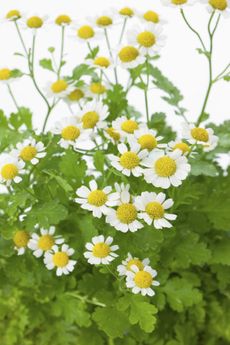Growing Feverfew Herb In The Garden


The feverfew plant (Tanacetum parthenium) is actually a species of chrysanthemum that has been grown in herb and medicinal gardens for centuries. Read on to learn more about feverfew plants.
About Feverfew Plants
Also known as featherfew, featherfoil, or bachelor's buttons, the feverfew herb was used in the past to treat a variety of conditions such as headaches, arthritis, and as the name implies, fever. Parthenolide, the active ingredient in the feverfew plant, is being actively developed for pharmaceutical application. Looking like a small bush that grows to about 20 inches (50 cm.) high, the feverfew plant is native to central and southern Europe and grows well over most of the United States. It has small, white, daisy-like flowers with bright yellow centers. Some gardeners claim the leaves are citrus scented. Others say the scent is bitter. All agree that once the growing feverfew herb takes hold, it can become invasive. Whether your interest lies in medicinal herbs or simply its decorative qualities, growing feverfew can be a welcome addition to any garden. Many garden centers carry feverfew plants or it can be grown from seed. The trick is knowing how. To grow feverfew from seed you can start indoors or out.
How to Grow Feverfew
Seeds for growing feverfew herb are readily available through catalogs or found in the seed racks of local garden centers. Don't be confused by its Latin designation, as it is known by both Tanacetum parthenium or Chrysanthemum parthenium. The seeds are very fine and most easily planted in small peat pots filled with damp, loamy soil. Sprinkle a few seeds into the pot and tap the bottom of the pot on the counter to settle the seeds into the soil. Spray water to keep the seeds moist as poured water may dislodge the seeds. When placed in a sunny window or under a grow light, you should see signs of the feverfew seeds germinating in about two weeks. When the plants are about 3 inches (7.5 cm.) tall, plant them, pot and all, into a sunny garden spot and water regularly until the roots take hold. If you decide on growing feverfew directly in the garden, the process is much the same. Sow the seed in early spring while the ground is still cool. Sprinkle the seeds on top of the soil and lightly tamp to make sure they make full contact. Don't cover the seeds, as they need sunlight to germinate. As with the indoor seeds, water by misting so you don't wash the seeds away. Your feverfew herb should sprout in about 14 days. When the plants are 3 to 5 inches (7.5-10 cm.), thin them to 15 inches (38 cm.) apart. If you choose to grow your feverfew plant somewhere other than an herb garden, the only requirement is that the spot be sunny. They grow best in loamy soil, but aren't fussy. Indoors, they tend to get leggy, but they flourish in outdoor containers. Feverfew is a perennial, so cut it back to the ground after frost and watch for it to regrow in the spring. It re-seeds fairly easily, so you might find yourself giving away new plants within a couple of years. The feverfew herb blooms between July and October.
Gardening tips, videos, info and more delivered right to your inbox!
Sign up for the Gardening Know How newsletter today and receive a free download of our most popular eBook "How to Grow Delicious Tomatoes."

Jackie Rhoades began writing for Gardening Know How in 2010.
-
 Urban Composting Guide: How To Compost In The Middle Of The City
Urban Composting Guide: How To Compost In The Middle Of The CityUrban composting does not have to be daunting. You can compost in the city, and maybe even try some urban worm composting!
By Mary Ellen Ellis
-
 Shrub Diseases And Pests To Watch Out For
Shrub Diseases And Pests To Watch Out ForShrub diseases and pests can be challenging. Learn how to recognize and eradicate them before they can present a danger to your plants.
By Susan Albert
-
 Feverfew Benefits: Learn About Herbal Feverfew Remedies
Feverfew Benefits: Learn About Herbal Feverfew RemediesThere are a number of traditional benefits of feverfew that have been used for hundreds of years plus new scientific research has given rise to the promise of yet another feverfew benefit. Click this article to learn about feverfew remedies and their benefits.
By Amy Grant
-
 Harvesting Feverfew Herbs: How To Harvest Feverfew Plants
Harvesting Feverfew Herbs: How To Harvest Feverfew PlantsThe harvesting of feverfew herb seeds and leaves by these early societies was thought to cure everything. Today, it is once again becoming a staple in many perennial herb gardens. If one of these gardens is yours, click here to find out more.
By Amy Grant